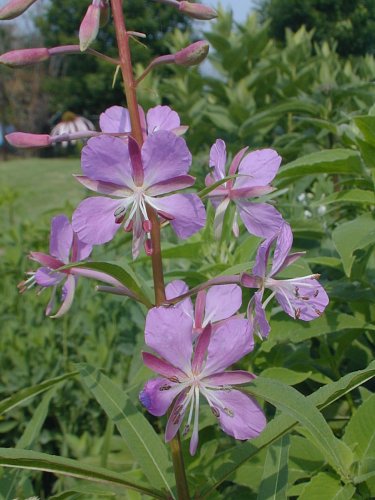Description: This perennial plant is 2-5' tall, and is either unbranched or sparsely branched. The smooth stems are round or somewhat angular; they often become reddish in the sun near the inflorescence. The willow-like hairless leaves are up to 5" long and ¾" across. They are narrowly lanceolate or linear, with margins that are smooth or slightly serrated (widely spaced), and are sessile or with short petioles. The central stem and upper side stems each terminate in an elongated raceme of showy flowers, about 3-8" long. These flowers range in color from pink to magenta, depending on the local ecotype.

Each flower is
about 1" across, consisting of 4 petals and 4 sepals. The petals are
narrow at the base, but become broad and rounded toward their tips. The
sepals are long and narrow; they are usually a darker color than the
petals. In the center of the flower, there are up to 8 long white
filaments with large magenta anthers; these anthers eventually shrivel
and turn brown. The pedicels of the flowers are rather long and colored
magenta. The blooming period occurs primarily from early to late
summer, and lasts about a month. There is no floral scent. The flowers
quickly wither away, and are replaced by seedpods that are long and
narrow. These seedpods split into multiple sections, beginning at their
tips (each section curling backward), and release a multitude of tiny
seeds with small tufts of white hair. These seeds are readily dispersed
by the wind, and can travel a considerable distance. The root system is
fibrous and rhizomatous, which enables this plant to form colonies.
Cultivation:
The preference is full or partial sun, moist conditions, and cool to
warm temperatures. This plant becomes dormant during hot summer
weather. The soil should contain abundant organic matter, with or
without sand. A low pH is tolerated, if not preferred. This plant is
fairly easy to grow, even under conditions that are not entirely
suitable for it, but it has difficulty competing with plants that are
better adapted to hot, dry summer weather. Foliar disease is not
troublesome; however, the stems are easily broken. In warmer areas with
a long growing season, Fireweed will bloom during early summer, while
in cooler, boreal areas, it tends to bloom later in the summer.

Range & Habitat:
The native Fireweed is a rare plant that occurs in only a few counties
of NE and
north central Illinois (see Distribution
Map). It is more common further to the north in Wisconsin.
Habitats include moist sedge meadows, woodland borders, damp ravines,
sandy marshes near dunes, remnant bogs, and areas where trees and brush
have been removed by fire. This plant is confined to cooler areas of
Illinois where the climate has been made more moderate by the influence
of the Great Lakes. It is not really a plant of the open prairies, but
can be found sometimes in moist meadows. Fire stimulates the
germination of this plant's seeds and helps to eliminate competitors,
hence the common name.
Faunal Associations:
Primarily long-tongued bees visit the flowers for pollen and nectar,
including bumblebees and leafcutting bees (Megachile spp.).
Smaller short-tongued bees and Syrphid flies also
visit the flowers, but they seek pollen and are probably less effective
at pollination (personal observations, Mitchell (1960/1962). Other
insects feed on the foliage, sap, and other parts of Fireweed (Chamerion angustifolium),
including such species as Altica
tombacina (a flea beetle), Bromius obscurus (a
leaf beetle), leaf-mining larvae of Mompha communis (a
Momphid moth), larvae of Hyles
lineata (White-lined Sphinx) and Hyles galii (Galium
Sphinx), nymphs of Aphrophora
gelida (Boreal Spittlebug), Aphis oenotherae
(Evening Primrose Aphid), Aphis
salicariae (Dogwood-Fireweed Aphid), and Aphis varians
(Currant-Fireweed Aphid); see Clark et al. (2004), Needham et al.
(1928), Wagner (2005), Marshall (2006), Robinson & Bradley
(1965), and Blackman & Eastop (2013). Many of these insects are
found north of Illinois where Fireweed is more common. The seeds of
this plant are too
small to be of much interest to birds. The foliage is palatable to
various mammalian herbivores, but it has relatively low food value.
Photographic Location:
The photographs were taken at the webmaster's wildflower garden in
Urbana, Illinois.
Comments:
Fireweed (Chamerion
angustifolium) is attractive while in bloom, but it
becomes ragged in appearance
afterwards. This plant can't be confused with most willow-herb species (Epilobium
spp.) because of their much smaller flowers. However, its
flowers are similar in size to those of Hairy Fireweed (Epilobium
hirsutum), which
is not native to Illinois. This latter plant has spreading
hairs that are soft and long, while Fireweed (Chamerion
angustifolium) is
hairless. A scientific synonym of this plant is Epilobium angustifolium.